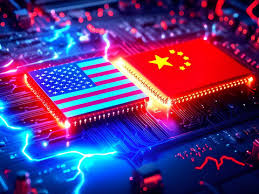The Trillion Dollar Race: Geopolitics and Physics Collide in the Battle for Semiconductor Supremacy
Editor
Jun 20, 2025
min read
4 views

The global semiconductor industry, the bedrock of the entire digital economy, is in a state of unprecedented flux in 2025. It has become the central arena for a new era of great power competition, where geopolitical ambition, national security, and the fundamental laws of physics are colliding. With the industry projected to surpass $700 billion in revenue this year and on a clear trajectory towards $1 trillion by 2030, the race to design and fabricate the world's most advanced microchips has never been more intense. This battle for semiconductor supremacy is reshaping global supply chains, fueling technological nationalism, and forcing nations to make colossal investments to secure their digital future.
At the heart of this struggle is the relentless push to shrink transistors to atomic scales. For decades, Moore's Law—the observation that the number of transistors on a chip doubles approximately every two years—has been the engine of technological progress. Now, as leading foundries like TSMC and Samsung push towards the 2-nanometer and even 1.4-nanometer manufacturing nodes, they are hitting the physical limits of silicon. This has ignited a furious innovation race in new materials, like graphene and III-V semiconductors, and new architectures, such as 3D stacking and advanced packaging (like chip-on-wafer-on-substrate, or CoWoS), to continue packing more power and efficiency into smaller spaces.
The overwhelming driver of this demand is the explosive growth of artificial intelligence. Generative AI models and the massive data centers required to train and run them have created a voracious appetite for high-performance GPUs, high-bandwidth memory (HBM), and other specialized AI accelerators. Chip revenue from AI alone is expected to exceed $150 billion in 2025, making it the most lucrative and fiercely contested segment of the market.
This technological race is inseparable from the geopolitical landscape. The over-concentration of advanced chip manufacturing in a few locations, primarily Taiwan (home to TSMC), has been identified as a critical global vulnerability. This has spurred governments in the United States, Europe, and Japan to enact sweeping industrial policies aimed at onshoring and 'friend-shoring' production. The U.S. CHIPS and Science Act and the European Chips Act are multi-billion-dollar initiatives designed to build domestic fabrication plants (fabs), foster R&D, and reduce reliance on East Asia. "What we are witnessing is the de-globalization of the semiconductor supply chain," commented a senior analyst at a global trade consultancy. "The goal is no longer just efficiency and cost, but resilience and strategic autonomy."
These policies are creating new hubs of semiconductor activity but also introducing friction into the global system. Tariffs, export controls, and strategic alliances are being used as tools of statecraft. The U.S. has implemented stringent restrictions on the export of advanced semiconductor technology to China, aiming to slow its military and technological advancement. In response, Beijing has poured massive state subsidies into its own domestic chip industry, striving for self-sufficiency. This 'chip war' has created uncertainty and forced companies to navigate a treacherous political landscape, often having to choose between markets and adhere to complex trade rules.
Furthermore, the industry is facing a severe talent crisis. The rapid expansion of manufacturing capacity has created a massive shortage of skilled engineers, technicians, and specialists in areas like VLSI (Very Large Scale Integration) design and quantum computing. A recent KPMG survey of industry executives highlighted talent acquisition as one of the most pressing challenges for 2025. Companies and governments are now scrambling to partner with universities and launch extensive training programs to build the necessary workforce to operate the next generation of fabs.
As 2025 unfolds, the semiconductor industry is being pulled in multiple directions at once. It is a story of incredible scientific innovation pushing the boundaries of physics, set against a backdrop of intense geopolitical rivalry. The quest for smaller, faster, and more powerful chips continues unabated, but the path to production is now paved with national security concerns, strategic investments, and a global battle for talent and resources. The outcome of this trillion-dollar race will not only determine which companies and countries lead the next wave of technological innovation but will also define the new world order for decades to come.
Editor
League Manager Editorial Team





Leave a Comment